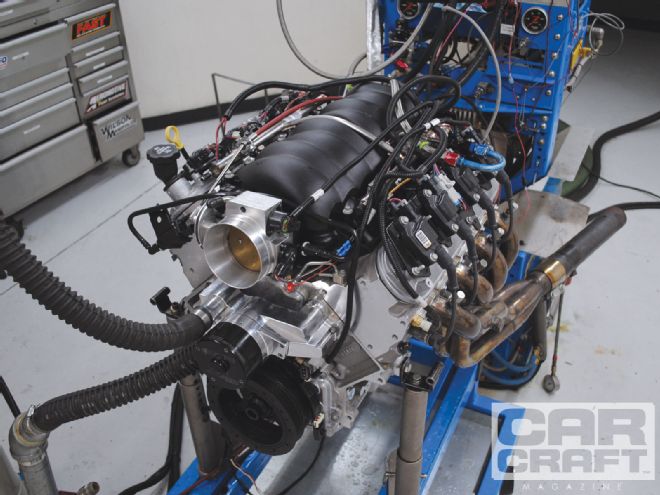
Let's face it, not all crate motors are created equal. In a world in which remachined, remanufactured, and reconditioned all blur into one seemingly unremarkable product, it is refreshing to see that the word new still applies. Nowhere is this more evident than in the current lineup of crate engines available from GM Performance Parts. Using our LS3 as an example, the combination is essentially a brand-new Corvette LS3 plucked from the assembly line. Rated at 430 hp and 424 lb-ft, the LS3 crate engine has more going for it than just the impressive power output. How many crate engines can offer the level of research and development and attending reliability that went into a production engine? Corvette owners fully expect an LS3 to run flawlessly for 100,000 miles or more. You'd be hard pressed to find that level of engineering in any other crate motor that didn't originate at the OEM level.
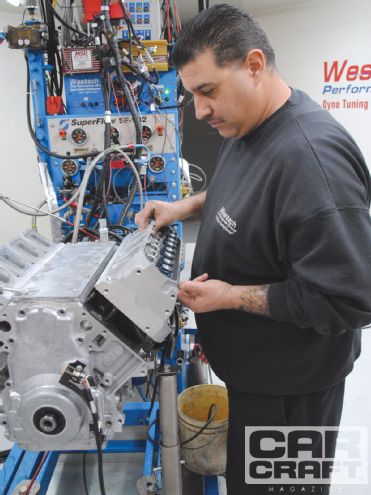 Swapping the heads and cam on an LS3 can yield some significant power gains.
Swapping the heads and cam on an LS3 can yield some significant power gains.
Starting with an increase in displacement, the LS3 checks in at 6.2 liters (376 ci) versus the previous 6.0L LS2 combination. This comes courtesy of an increase in bore from 4.00 inches (in the LS2) to 4.065 inches, while the two share the same stroke of 3.622 inches. Combine this with a revised cylinder head that replaced the cathedral-port design with a more conventional rectangular port and you have the makings of a serious small-block. The production LS3 heads flow more than 315 cfm right out of the box.
The massive flow potential of the LS3 heads allowed GM to reach its power goals for the production LS3 using relatively mild cam timing. GM went back to its successful (early) LS6 grind and applied it to the LS3. The stock LS3 cam offers a 0.551/0.522 lift and 204/211 duration at 0.050 with a wide lobe-separation angle of 117 degrees. The combination of this mild cam timing and the impressive LS3 head flow means the LS3 motor will respond very favorably to cam upgrades. To illustrate the potential lurking in the LS3, we applied a select few factory performance upgrades to our GMPP LS3 crate motor. We chose a set of GMPP CNC-ported LS3/L92 cylinder heads and a roller cam. What we liked about the GMPP heads was that not only did they offer exceptional flow numbers (see flow data), but they were also a trouble-free bolt-on because they were essentially factory components. Recognizing the mild factory cam specs, we also opted to replace the wimpy factory LS3 cam with a much more performance-oriented stick from Comp Cams.
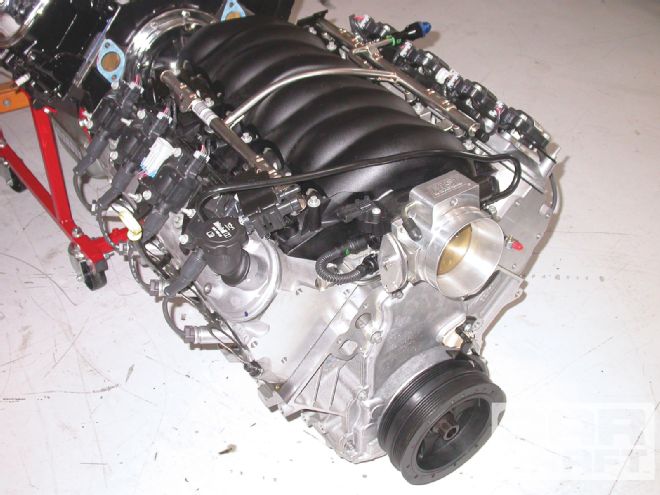 The GMPP crate motor was essentially a 6.2L LS3 Corvette mill. Rated at 430 hp and 424 lb-ft, in the right chassis, the LS3 offered 11-second performance even in stock trim.
The GMPP crate motor was essentially a 6.2L LS3 Corvette mill. Rated at 430 hp and 424 lb-ft, in the right chassis, the LS3 offered 11-second performance even in stock trim.
Those who have jumped ahead already know the combination offered sizable power gains, but before getting to the dyno numbers, there were a few installation tricks that bear mentioning. Before we could run the GMPP LS3 on the engine dyno, a few changes were necessary. Off came the factory drive-by-wire throttle body and on went a more dyno-friendly manual throttle body from FAST. The stock exhaust manifolds were also replaced with a set of 13/4-inch, long-tube headers. The production water pump was likewise ditched in favor of a Meziere electric unit (the LS3 was run sans accessories). All testing was run with the stock injectors controlled by the FAST XFI management system. After filling the crankcase with Lucas 5W-30 (nonsynthetic) oil, the motor was treated to a break-in procedure prior to running in anger. After the break-in and some quick tuning by Westech's Ernie Mena, the LS3 belted out some pretty impressive numbers. Torque production exceeded 450 lb-ft from 3,900 rpm to 5,700 rpm and more than 400 lb-ft from 3,000 rpm to 6,300 rpm. These are the kind of numbers we'd expect from a 383 stroker small-block with a healthy cam, free-flowing aftermarket heads, and a good dual-plane high-rise.
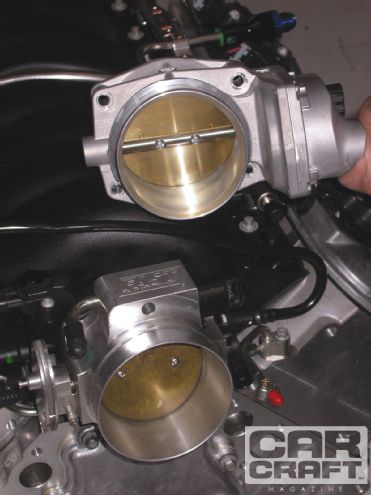 The factory drive-by-wire throttle body made way for a manual FAST 102mm Big Mouth throttle body.
The factory drive-by-wire throttle body made way for a manual FAST 102mm Big Mouth throttle body.
After running the motor in stock trim, off came the stock LS3 heads to make room for the CNC-ported L92 heads. GMPP sells the CNC-ported L92 heads with stock valvesprings. While adequate with the stock cam, they are insufficient for performance use with almost any aftermarket cam, including the more than 0.600 lift from the stick supplied by Comp Cams for this test. The Comp Xtreme Energy hydraulic roller cam featured a 0.617/0.624 lift and a 231/239 duration at 0.050. The wide, 113-degree lobe-separation angle improved idle quality and will work equally well with the displacement hike and forced induction we have planned for this combination. In terms of valvesprings, GMPP offered a set of LS6 springs as an upgrade for the stock springs supplied with the CNC-ported heads. Unfortunately, they actually provide little (if any) additional spring pressure over the stock springs. What they do offer is additional lift before coil bind, but even these were deemed insufficient for use with our high-lift Comp cam. Rather than risk valve float, we replaced the stock springs with a set of beehive springs from Comp Cams. The Comp spring upgrade offered an increase in seat pressure of 30 pounds over the factory springs. Not wanting to reuse the torque-to-yield factory head bolts, the CNC heads were installed using Fel-Pro head gaskets and ARP head studs.
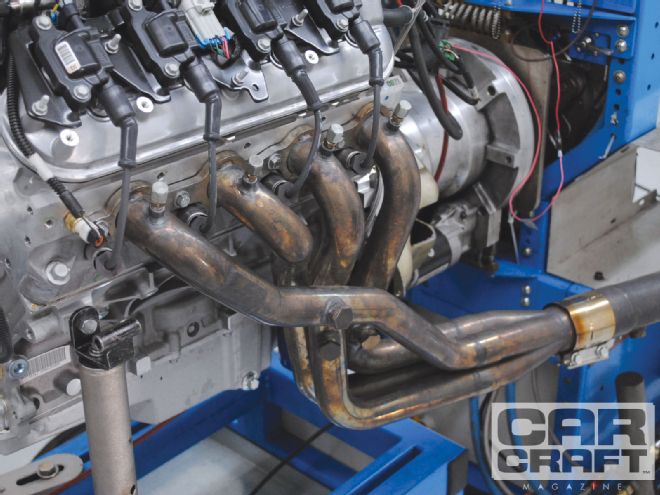 The factory exhaust manifolds were replaced by a set of 1 3/4-inch, long-tube headers.
The factory exhaust manifolds were replaced by a set of 1 3/4-inch, long-tube headers.
Given the mild cam timing and already impressive flow figures offered by the stock LS3 heads, we suspected the head upgrade would offer only minor power when combined with the stock cam, and we were right. Running the CNC-ported heads on the otherwise stock LS3 resulted in a jump in peak power from 492 to 503 hp. Peak torque was up slightly, from 484 lb-ft to 497 lb-ft, though at a slightly higher 4,900 rpm. What was not expected with this combination was the fact that the CNC-ported heads from GMPP improved the power output throughout the tested rev range, from 3,000 rpm to 6,500 rpm. The LS3 now offered a peak of nearly 500 lb-ft, and the torque curve bettered 450 lb-ft from 3,600 rpm to 5,900 rpm, making for an exceptionally broad torque curve. Given the already impressive flow figures and port volume of the stock LS3 heads, a cam would be a better choice than ported heads if you had to choose one or the other. But as we shall see, the combination offered some serious power.
On the cam side, the factory LS3 cam was secured to the timing gear via a single retaining bolt. Most aftermarket LS cams (including ours from Comp Cams) still feature the early three-bolt retaining pattern, so it was necessary to replace the factory upper timing gear with a new version that featured the three-bolt pattern and the requisite cam sensor lobes. The cam sensor is located on the back of the cam on early LS motors, but the LS3 featured a cam sensor mounted in the front cover. The new timing gear was available directly from GM for less than $30. The factory hydraulic roller lifters, rockers, and pushrods were reused with the new GMPP heads and Comp cam. Cam swaps on LS motors are simple, especially on the engine dyno, as they do not require removal of the intake manifold or lifters. Simply rotate the cam and the plastic retainers will hold the lifters in place while you swap the cams. The Comp cam upgrade not only improved the peak power numbers significantly but also offered gains throughout the rev range, from 3,000 rpm to 7,000 rpm. Big chunks of power came after 4,000 rpm, but even down at 3,000 rpm, the cam offered an additional 4-6 lb-ft. Impressed as we were with the head and cam upgrade on the GMPP LS3, we couldn't help but wonder what it would be like with a little more displacement and even some boost. Stick around as we add forged internals and a supercharger to the equation.
A cam swap was what the LS3 really needed. The Comp Xtreme Energy hydraulic roller cam featured a 0.617/0.624 lift split, a 231/239 duration at 0.050, and a 113-degree lobe-separation angle. The ported heads responded very well to the high lift supplied by the new cam profile. The cam swap improved the power output of the LS3 from 503 hp and 497 lb-ft to 569 hp and 522 lb-ft. Despite the healthy cam specs, the hydraulic roller cam never lost ground to the factory cam, even down at 3,000 rpm.
STOCK LS3
CNC HEADS COMP CAM
RPM
TQ
HP
TQ
HP
3,100
417
246
432
255
3,300
417
262
435
273
3,500
428
285
446
297
3,700
442
311
458
322
3,900
451
335
471
350
4,100
462
361w
494
386
4,300
471
386
509
417
4,500
482
413
512
438
4,700
484
433
514
460
4,900
483
451
517
482
5,100
480
466
521
506
5,300
474
478
521
525
5,500
466
488
517
541
5,700
454
493
509
552
5,900
438
492
497
559
6,100
420
488
487
566
6,300
403
483
473
568
6,500
386
478
459
569
6,700
369
470
443
565
6,900
348
457
--
--
AIRFLOW DATA: CNC-PORTED GMPP L76/L92 FLOWED WITH 4.065 BORE Lift Intake Exhaust 0.200 150 105 0.300 222 140 0.400 260 168 0.500 298 190 0.600 332 201
PARTS LIST DESCRIPTION PN SOURCE PRICE Comp cam 281LRHR13 Comp Cams $417.59 Comp Cams valvesprings 26918 Jegs 174.99 Fast 102mm Big Mouth TB 54102 Morano Racing 558.99 GMPP L76/L92 CNC heads 88958698 Pace Performance 1,388.50 GM cam sprocket 12586481 SDPC* 28.59 GM LS3 controller kit 19201861 SDPC 1,506.39 GM muscle car oil pan kit 19212593 SDPC 125.80 GM harmonic balancer 12620556 SDPC 103.19 GM Y-body FEAD 19155067 SDPC 825.85 GMPP LS3 crate engine 19201992 Summit Racing 7,440.39 McLeod LS flywheel 460535 Summit Racing 425.30 *Scoggin-Dickey Parts Center